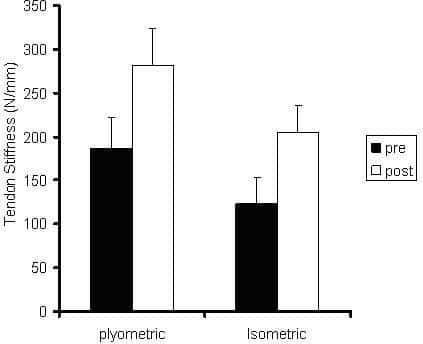Previous studies have shown that the rate of force development (RFD) has a significant relationship with sporting events requiring high power output (Wilson & Murphy, 1995; Young et al. 1995). Traditional methods used to develop RFD favour plyometric techniques. However, due to the nature of the loading (short duration, high impact forces) there is a risk of musculotendinous injury (Humphries et al. 1995). Other training regimens such as isometric loading may induce similar benefits to that of plyometric training in terms of RFD with a reduced risk of injury. No attempt to compare the efficacy of plyometric vs. isometric resistance training with respect to RFD has previously been made. The aim of this study was therefore to examine changes in rates of force development of the plantar flexors in response to training. In addition, as the rate at which force can be developed is influenced by the tendon stiffness (Kubo et al. 2001), changes in the gastrocnemius tendon stiffness were measured using B-mode ultrasonography as in Maganaris & Paul (2002). Two groups (n=11) were trained for 6 weeks (3 times per week plyometric vs. isometric). The investigation was approved by the Salford University Institutional Ethics Committee and all subjects gave their written informed consent to participate in the study which conformed with the principles of the World Medical Associations Declaration of Helsinki. Student’s t tests were used to analyse data, alpha values were set to p=0.05. Significant increases in the gastrocnemius tendon stiffness were seen, with increments of 51.2 % (p=0.03) and 65.8 % (p=0.04) for the plyometric and isometric groups, respectively (Fig. 1). Concentric rate of force development (initial 150 ms from onset of force) showed trends for improvements after training of 24.4 % (p=0.06) and 60.7 % (p=0.21) in both the plyometric and isometric groups, respectively (Fig. 2). No significant differences were found between the groups for changes in either tendon stiffness or rate of force development. The results suggest that isometric training can be effectively utilised to bring about similar changes in rates of force development and tendon stiffness to that of plyometric training without the additional risks of injury normally associated with the plyometric methods.
University of Bristol (2005) J Physiol 567P, PC217
Poster Communications: Training, rate of force development and tendon stiffness
Connick, Mark; Burgess, Katherine; Graham Smith, Philip; Pearson, Stephen John;
1. Sport, University of Salford, Manchester, United Kingdom.
View other abstracts by:
Figure 1. Gastrocnemius tendon stiffness before and after 6 weeks of training. *Significantly different (p = 0.03 and 0.04) stiffness compared with pre-training values for the plyometric and isometric groups respectively. Data are mean ± S.E.M.
Figure 2. Influence of training regimen on rate of concentric force development. Data are mean ± SEM.
Where applicable, experiments conform with Society ethical requirements.


